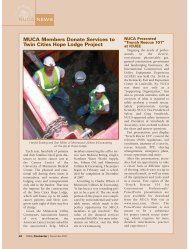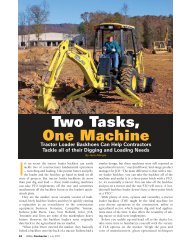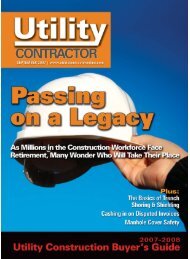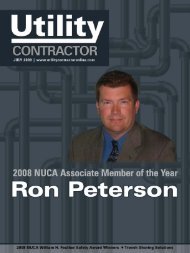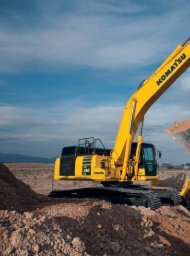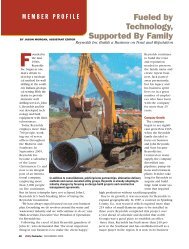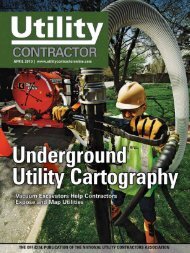View Full August PDF Issue - Utility Contractor Online
View Full August PDF Issue - Utility Contractor Online
View Full August PDF Issue - Utility Contractor Online
- No tags were found...
Create successful ePaper yourself
Turn your PDF publications into a flip-book with our unique Google optimized e-Paper software.
SAFETY MANAGEMENTManaging Electrical PowerLine HazardsBy George KennedyMany construction operations require workersto perform their jobs in proximity tooverhead and underground power lines.It is therefore imperative that constructionworkers, equipment operators, truck drivers and othersbe trained to recognize the dangers of letting their bodies,equipment, tools or vehicles make contact with, orcome too close to, power lines.Unfortunately, the reality is that while electrical utilityworkers are routinely trained to recognize and manageelectrical hazards, most construction workers arenot. That lack of knowledge of the potential electricalhazards present in their work environment makes themmore vulnerable to electrocution, electric shock, burnsand falls caused by contact with electrical energy.For example, many construction workers do not knowthat the coating on overhead power lines is only there toprotect the conductor from the weather; it is not electricalinsulation. Nor do they know that most constructionelectrocutions are due to equipment making contact witha power line, which in turn electrocutes workers workingin contact with the equipment or materials being handled.Even a brief contact with low-voltage lines can killa worker or result in serious, disfiguring and/or debilitatinginjuries.The data clearly show that a high number of constructionworkers have been killed or seriously injureddue to contact with power lines. For example, in 2005,the Bureau of Labor Statistics (BLS) reported that 107construction workers were fatally injured by contactwith electricity. Of the 107 workers killed, 49 diedbecause of contact with overhead power lines. An additional627 were seriously injured when they contactedpower lines — 313 through contact with overhead lines,314 with underground lines. According to the NationalInstitute for Occupational Safety and Health (NIOSH),electrocutions from contact with overhead power linesresult on average in 128 work-related fatalities per year.Managing the HazardAll power lines present a potential hazard. The firststep in controlling electrical hazards is to assume that allpower lines are energized and avoid making contact —unless the electric utility company has verified that thelines have been de-energized and grounded.Notify the power company before starting the work andgive them an opportunity to reduce the hazards and makethe power line electrically safe. Although it is often difficultand may be impossible for the power company to deenergizethe lines, there are other things it might be ableto do to reduce the exposure, such as place protectivecovers over the lines or temporarily relocate lines.However, employees should be made aware of the factthat insulating sleeves alone might not allow equipmentand workers to work safely close to lines.“While electrical utilityworkers are trained torecognize and manageelectrical hazards, mostconstruction workers arenot. That lack of knowledgemakes them vulnerableto electrocution, electricshock, burns and falls. ”44 <strong>Utility</strong> <strong>Contractor</strong> | <strong>August</strong> 2007




